


ENESS
Modern Guru
Modern Guru is a translucent ovoid with four huge digital eyes, floating above a ceremonial ring of LEDs. From his mouth flows a ream of absurdist messages, and in a statement about the true nature of lived experience, a new message is delivered when visitors take a photo of Modern Guru – a missive produced only for those who seek to photograph life rather than live the moment. This immersive new media art installation uses the intersection of art and technology to explore modern paths to happiness through unique interactions with characters along a mystical journey of discovery. Visitors are asked to commit to the path – a tight and winding trail with subtle points of connection along the way – a glowing landscape of oversized, whimsical mountains that chant incantations and blink innocently from digital eyes.
Having communed with the Guru, visitors then weave their way back through this warped and strange world full of illusions and delusions, perceptions and deceptions, all the while bathing in luminescent light; embracing big, gentle forms; and following their own path up the pink tongue staircase to meet the one who oversees the whole fantastic dominion, the Sun God.
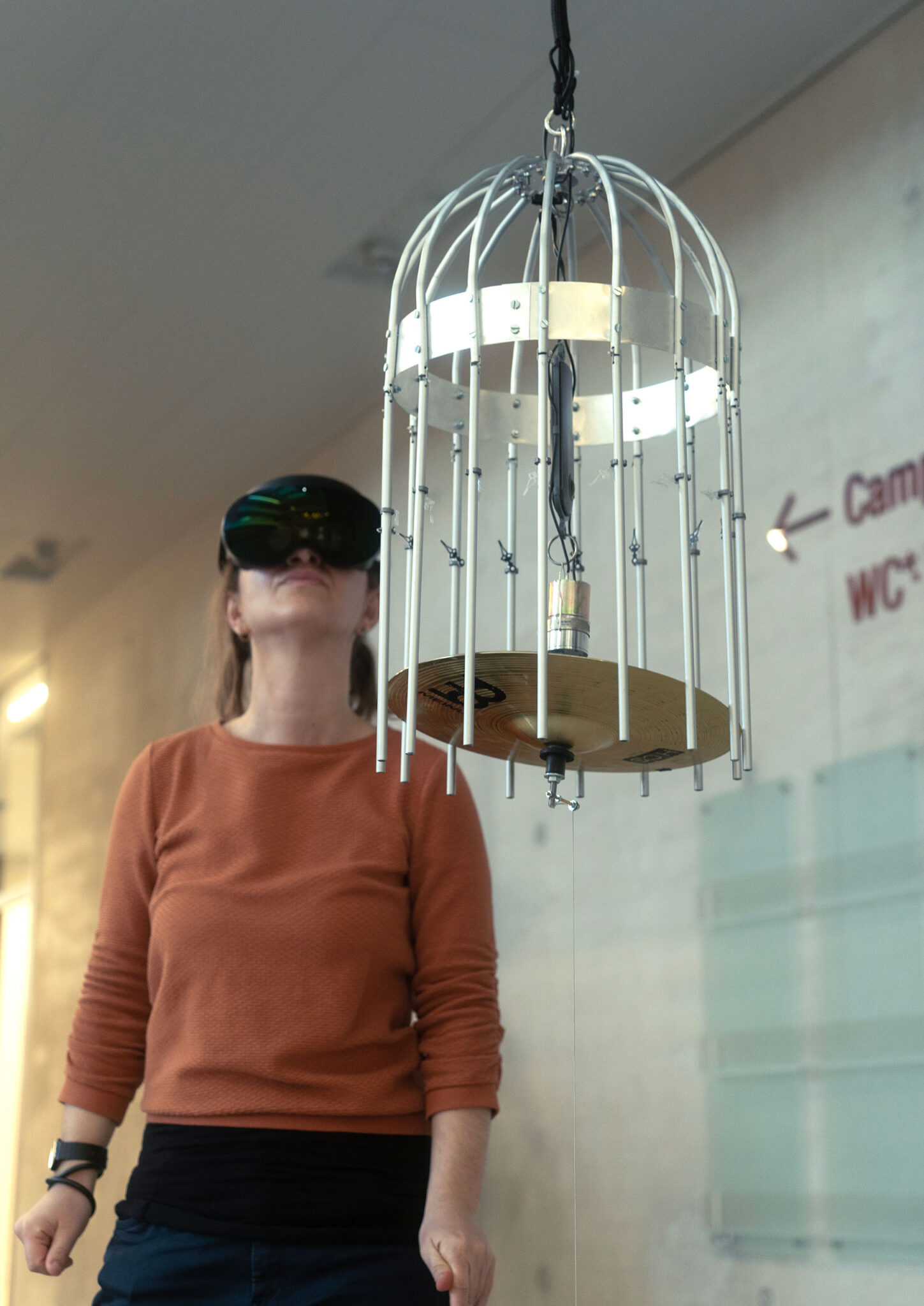
QUBIT AI: Anna Vasof & VRinMotion Team
The Cage of Time
FILE 2024 | Installations
International Electronic Language Festival
Interactive installation that presents a kinetic instrument object and virtual reality glasses, functioning as a device that animates the illusion of the passage of time in virtual space. In the fabric of existence, time weaves a cage around our ephemeral moments, limiting our perceptions of the past, present and future. By embracing this paradox, we may discover that the cage of time becomes the crucible where the alchemy of experience transforms our understanding of existence.
Bio
Anna Vasof is a multi-award-winning artist who focuses on filmmaking, short videos, and time-based sculptures. VRinMotion is an artistic research project based at St. Pölten University of Applied Sciences in Austria that investigates how features of stop-motion animation and motion capture can be combined with virtual reality to enrich current artistic discourse.
Credits
VRinMotion Team: Franziska Bruckner, Christoph Schmid, Clemens Gürtler, Matthias Husinsky, Christian Munk, Julian Salhofer, Stefan Nebel, Vrääth Öhner.
Concept by: Anna Vasof.
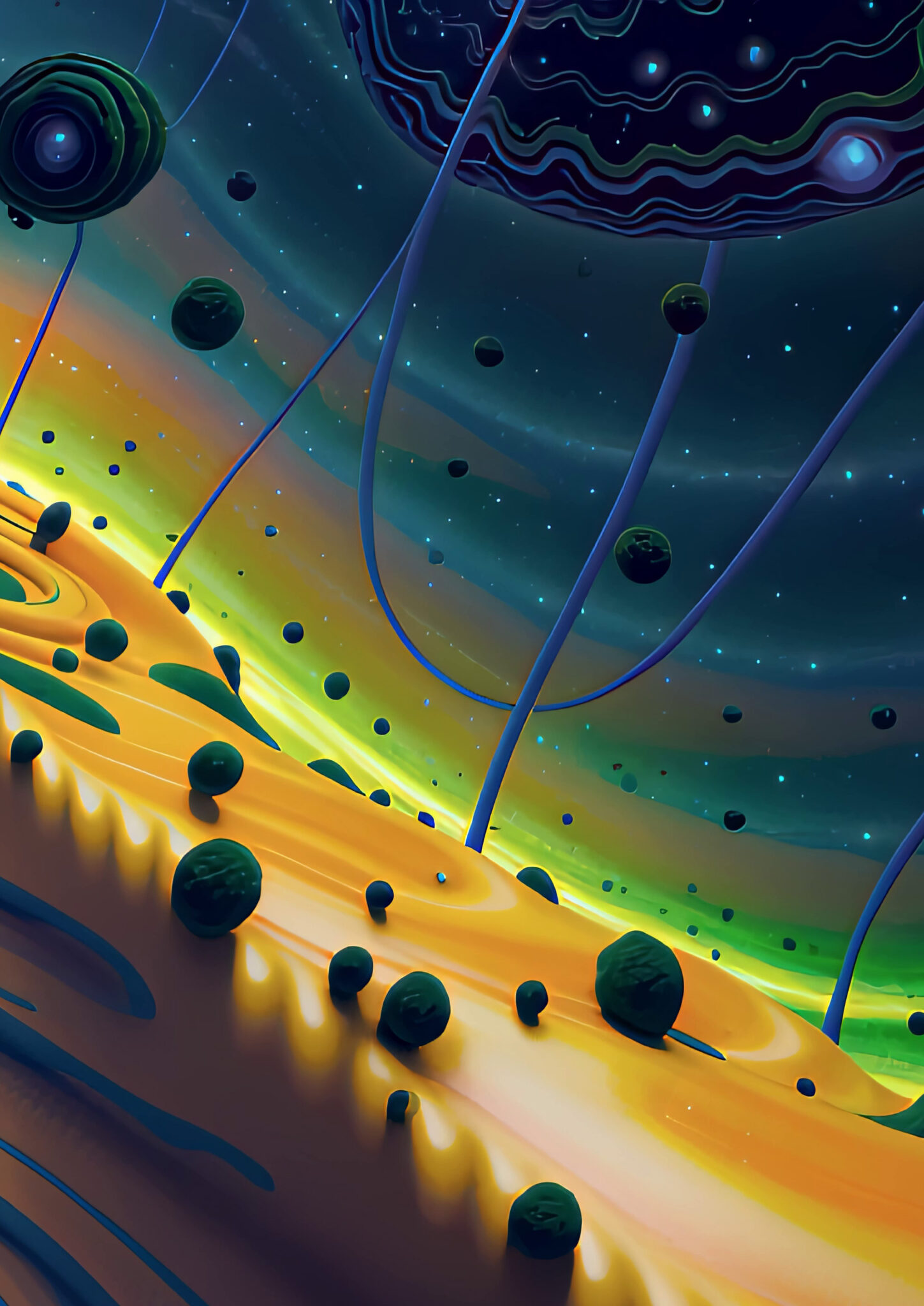
QUBIT AI: Michael Sadowski (aka derealizer)
Distortions of The Past
FILE 2024 | Aesthetic Synthetics
International Electronic Language Festival
Michael Sadowski (aka derealizer) – Distortions of The Past – Austria
Fractal elements that resemble cosmic structures evoke the illusion of traveling through a fractal universe. Rules, in the form of prompts, and chance interact with each other to create a visual fantasy.
Bio
Using Stable Diffusion, a visual synthesizer, the artist turns fantasies into videos using just a PC, similar to the invention of printing 600 years ago. Exploring the interplay between software algorithms that create visual worlds and the artist’s mind guiding this process is incredibly exciting. Unlike traditional cinema, there is no ‘reality’ or humans involved, making it a satisfying medium for creating visual art.
Credits
Visuals: Michael Sadowski
Music: Distortions of the Past by Dreamstate Logic

Olafur Eliasson
DET LYTTENDE SPEJL
Visitors to DNV-Gødstrup, a new hospital near Herning, Denmark, are greeted at the main entrance by an airy, round pavilion. Two curved pipes, crossing one another perpendicularly, hold a large disc aloft at a slight angle. The reflective underside of the disc mirrors the semicircular pipes, creating the illusion of two complete circles passing through the ceiling and rising into an imaginary space above. As visitors enter the pavilion, they can gaze up at their own reflections in the mirror and see themselves incorporated, upside down, into the artwork, embraced within the globe drawn by the pipes. The tilt of the ceiling allows the reflections to be seen from the outside. As the viewer moves towards and around the pavilion, the rings appear to shift in shape, changing from ellipses to circles and back again.

bohyun yoon
БОХЬЮН ЮН
윤보현
To Reverse Yourself
My work poses the question: how does reality becomes exquisitely animated by certain social control systems such as politics, mass media, technology, science, and etc. It is my artistic goal to reveal how human beings are fragile and delicate in these social environments. By living in Korea, Japan and the U.S, I have first-hand experience in diverse social systems and have come to view my life experiences as raw material for my research. With my research in mind, my art utilizes the body as the tool for an intensive investigation of the public and private; examining the relationship between how people understand their body and how this understanding represents themselves in the greater context.
Currently, I am curious about human perception developing parallel with the ever-evolving progression of technological world. Thus, I question technology’s relationship to reality and illusion; asking what is reality? My work takes advantage of illusion to explore and answer this question, and often my artistic materials consist of the body and mirrors. I use mirrors for integrating reality and illusion.

Jacqueline Hen
Light High
The installation LIGHT HIGH is aimed at guiding the perception through targeted acoustic and visual phenomena into border areas in which ambivalent experiences set in and the habitual experience of space is abolished.[…] A mirrored ceiling together with a thin reflecting surface of water on the ground and a grid arrangement of lights are creating the spatial illusion of an infinite vertical space of light and darkness. By traversing a small bridge, the visitor can cautiously discover the immersing endlessness beneath his/her feats and above his/her head.

JOANIE LEMERCIER
EYJAFJALLAJÖKULL
Inspired by the icelandic volcano, which wreaked travel havoc across europe, Joanie Lemercier presents the latest incarnation of its audiovisual mapping project painted directly onto a large wall, a wireframed scenery is slowly revealed by gentle light effects. The audience’s sense are progressively challenged as optical illusions question their perception of space.
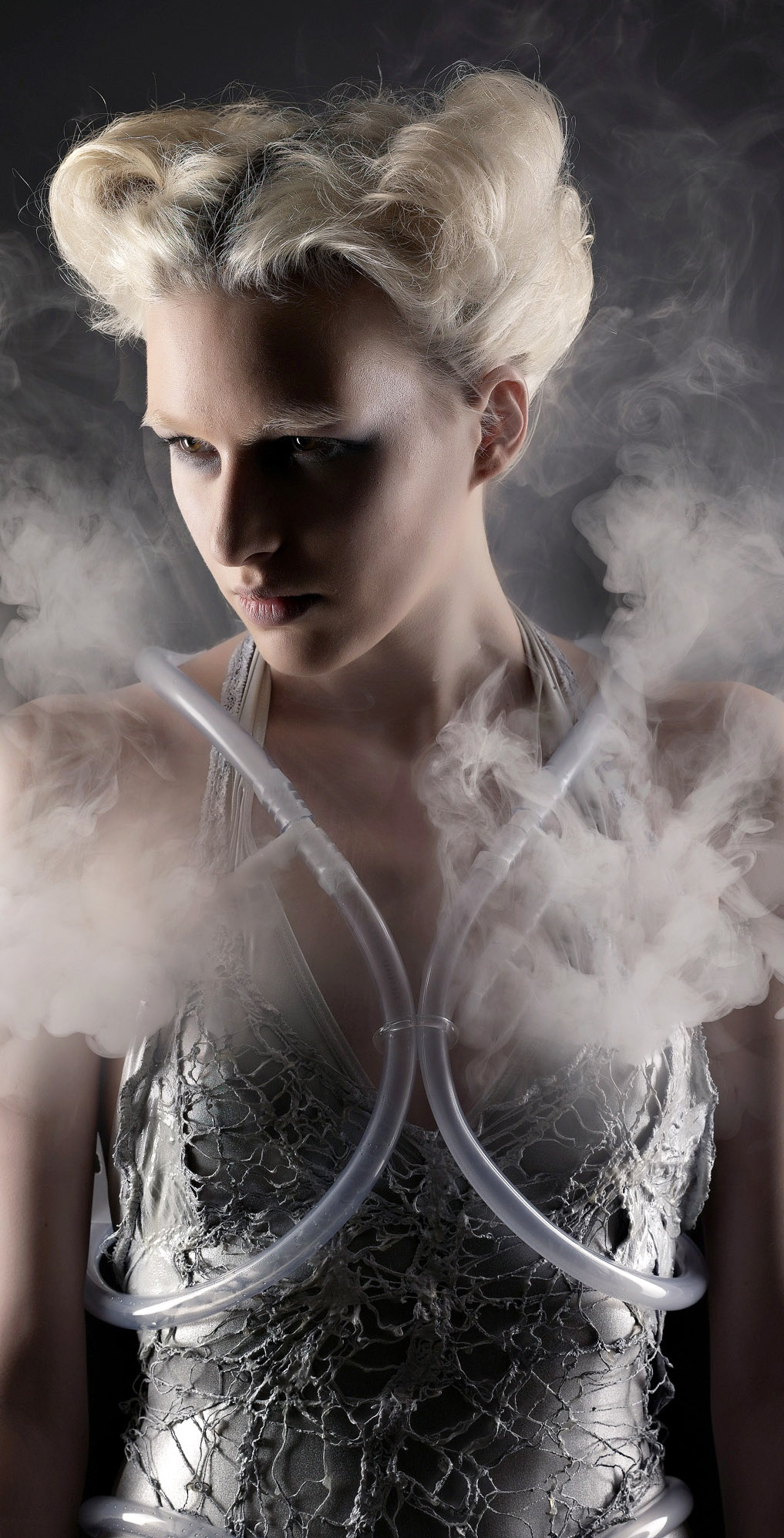
ANOUK WIPPRECHT AND ADUEN DARRIBA
Rook Jurk
Collega-ontwerper Valerie Lamontagne schrijft: “SMOKE DRESS is een samenwerking tussen fashiontech-ontwerper Anouk Wipprecht [NL] en technoloog Aduen Darriba [NL]. De jurk is een draadloze en draagbare tastbare couture “rookgordijn” doordrenkt met het vermogen om zichzelf plotseling visueel uit te wissen door de uitscheiding van een rookwolk. Omgevingsrookwolken worden gecreëerd wanneer de jurk een naderende bezoeker detecteert en zichzelf zo camoufleert in zijn eigen materialiteit. De ROOKJURK, met zijn losse net van metalen draden en elektrische draad, werkt op de schaal van de magische illusionistentruc, waardoor een hypothetische assistent van een goochelaar haar eigen verdwijnende act kan uitvoeren.
MIGUEL CHEVALIER
Pixel Nero Chiaro
“L’Origine du Monde” è un’installazione interattiva proiettata a terra (12 mx 7,50 m) ispirata alla biologia, ai microrganismi e agli automi cellulari. L’artista fonde le cellule, gli elementi base della vita con i pixel, gli elementi base dell’artificiale “vita”. Questi universi fluidi reagiscono visivamente in base ai movimenti dei visitatori. Le interruzioni nella traiettoria di queste cellule vengono create sotto i loro piedi. Le forme fluttuanti creano impressionanti illusioni ottiche.”
PROTOROOM Metamedia Collective
Metapixels
PROTOROOM es un colectivo de metamedia que trabaja con kits basados en medios tecnológicos (KITs). Aquí, el kit es un meta-medio que conduce al sentido y al pensamiento, y se convierte en un mediador que hace posible conectar el pensamiento y el discurso sobre la tecnología que es parte del ecosistema, junto con la oportunidad de sentir directamente los elementos fundamentales de la informática. medios de comunicación. Bajo la temática de este, continúa su serie de trabajos para desentrañar a través de exposiciones y talleres. Hunida Kim y Kim Seung-beom han estado activos desde 2014. Recientemente, en el formato de Exposición X Taller, participé en exposiciones especiales en el Centro de Intercomunicación NTT [ICC] Media Art as an Awareness Filer y Nam June Paik Art Center “Our Bright Future – Cybernetics Illusion” en Japón en 2016.
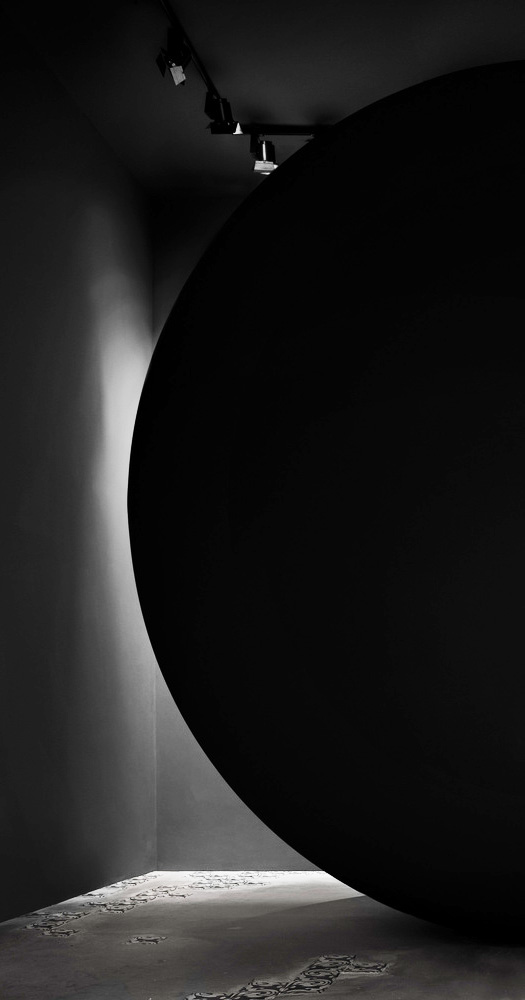
Larissa Sansour
Monument for Lost Time
Commissionato dalla Danish Arts Foundation per la 58a Biennale di Venezia, Monument for Lost Time prende un oggetto psicologico dalla finzione di In Vitro e lo converte in un fatto fisicamente imponente. La sfera è verniciata in Black 2.0, una tonalità così nera che non viene riflessa la luce. Questo trasforma la sfera in un’illusione ottica, rendendola virtualmente assente, ma allo stesso tempo intimidatoria e opprimente, come incarnazione di un trauma ereditato. I pavimenti sono in cemento, con piastrelle intervallate prodotte da una Anan Tiles di Nablus, creando un intervento architettonico. Le pareti sono grigio chiaro e un paesaggio sonoro basato su vibrazioni a bassa frequenza fa da sfondo.
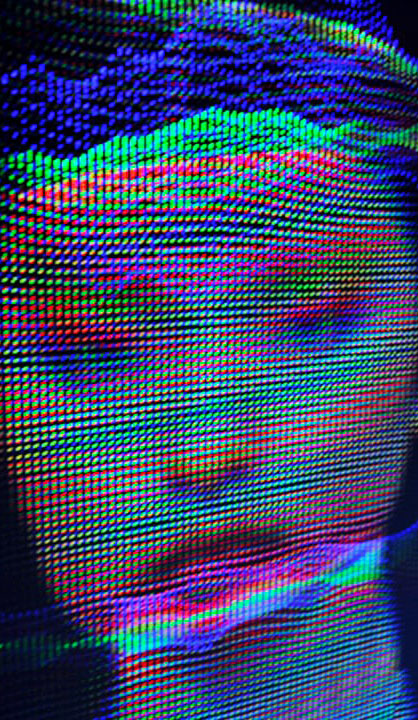
Onformative
Poiché la consapevolezza della realtà è soggetta all’individuo, »Frammenti di RGB« è un esperimento nella deformazione di questo fenomeno attraverso l’interazione e la proiezione di punti luce. Quando lo spettatore si avvicina a uno schermo illusorio, il contenuto cambia per alterare e dissolvere la realtà percepita.
»Frammenti di RGB« sperimenta la percezione e l’illusione a vari livelli. Il classico schermo a LED come supporto è stato simulato e successivamente disintegrato creando un’ottica pixel-like utilizzando una semplice proiezione anziché generare l’intera immagine da singoli punti luce.

RICHARD DUPONT
理查德·杜邦
리처드 듀퐁
Mr. Dupont makes these sculptures based on a full-body scan of his own body. He says viewers relate to them like they’re three dimensional illusions: The viewer walks around the figures and gets all these different perspectives as the surfaces change. That’s one way the distortions are interesting, because no two perspectives are the same.

clement valla
Valla claimed to have collected a series of 60 “surrealistic” images, or that, at least, give that impression, during a long period “playing” in Google Earth.“The images are a kind of mirrors for a fun house.They are strange illusions and reflections of the real ”Despite the strong distortions, which easily resemble a surrealist painting, the images of the work do not have any manipulation of tools like Photoshop, for example.”The images are screenshots of Earth with basic color adjustments”, “This is a construction of 3D maps on two-dimensional bases, creating these fabulous and unintended distortions”.

New Media Tribe
Bloom
BLOOM is kinetic laser and sound installation by TRIBE investigating illusions of stillness unfolding at speeds unable to be registered by human sight. It is named for intangible flower-like shapes produced by moving lasers filling all the space and bringing new dimension to surroundings.

LEANDRO ERLICH
Dalston House
Located in Hackney, Dalston House by Leandro Erlich is a temporary installation comprising a reconstructed house facade lying face-up and a mirror positioned over it at a 45-degree angle. As a person walks over the surface of the house, the mirror reflects their image and creates the illusion that they are walking up the walls. Similarly, visitors can make it look like they are balancing over the cornices or dangling from the windows.
ADRIEN M, CLAIRE B & MOURAD MERZOUKI
Pixel
Ein kleiner Vorgeschmack auf die einstündige Präsentation Die Verflechtung von Körperbewegungen mit Technologie ist keine leichte Aufgabe. Die Tanzshow besteht aus 11 Tänzern in einer virtuellen und lebendigen visuellen Umgebung. Es bedurfte der gemeinsamen künstlerischen Bemühungen der Künstler Adrien Mondot, Claire Bardainne von der Adrien M / Claire B Company und Mourad Merzouk von seiner Tanzkompanie Käfig, um Pixel zum Leben zu erwecken. Eine Illusionsarbeit, die Energie und Poesie, Fiktion und technische Leistung, Hip Hop und Zirkus kombiniert.

LUCID CREATES
Futures
Futures nutzt die optischen Täuschungen von Licht, Ton und Spiegeln, um das Publikum an einen Ort zu bringen, an dem gute Dinge geschehen sind und die Zukunft, die wir wollen, jetzt existiert. Futures ist ein immersiver Raum, in dem das Publikum Illusionen erlebt, die alles offenbaren können, von der Verarbeitung von Raum und Zeit bis zur Wahrnehmung des Bewusstseins. Es ist eine modulare Lichtinstallation, die verschiedene Formen annimmt. Es wird hier als Gehweg aus Spiegeln und Lichtern gezeigt, die nach innen zu einem Fluchtpunkt tunneln.

VINCENT LEROY
Illusionslinse
Der französische Künstler Vincent Leroy hat eine geodätische Installation vorgeschlagen, die auf dem Roppongi Hills Mori Tower in Tokio sitzen soll. Die jenseitige Sphäre nimmt eine ähnliche Form an wie ein Raumschiff, wobei drei starke Industriebeine ihren Sitz halten. Die Installation befindet sich 238 Meter hoch in der Mitte des Hubschrauberlandeplatzes auf dem Dach und bietet einen ruhigen Blick auf Tokios weitläufiges Stadtbild. Leroy bezeichnet den Kaleidoskopeffekt der Kugel genau als “Sampler of the Sky”, da er das umgebende Klima erfasst und das Bild in mehrere Teile zerlegt. Der Künstler entwarf die vorgeschlagene Installation als Flucht aus den geschäftigen Straßen Tokios, einem Ort, an dem man allein oder mit geliebten Menschen in Frieden nachdenken und reflektieren kann.
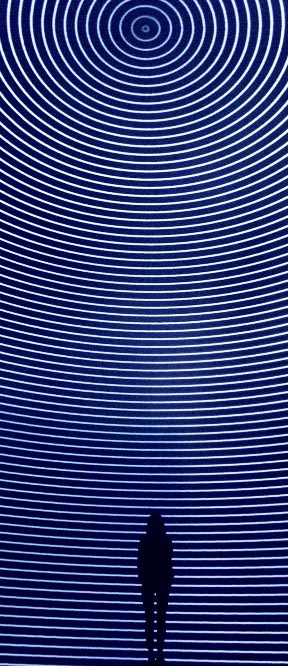
Nonotak
Versus
Elaborated by the French/Japanese duo Nonotak, ‘VERSUS’ is an immersive A/V experience that questions the relationship between 360° image and sound. The viewer finds himself submerged, at the centre of a perfectly geometric environment that constantly redefines space by breaking distances between projection, audience and screen. The work gives the illusion of a new type of architecture, a world created from distortions that shatter boundaries, and that brings the idea of infinity.

Whyixd
Through the Membrane
We define the space around us by observing and perceiving light and shadow. That is to say, our perception shapes our basic understanding of this sensory world, and hence the “reality” we believe in. If our experiential knowledge and awareness of space are challenged, would our definition of a “real phenomenon” also be changed? Through the Membrane utilizes optical polarizers to change how light passes through space. The installation does not rely on any electromechanical devices. Simply with creative use of material and structure, it presents a super-sensory experience in space where reality and illusion are inextricably juxtaposed.

Lucid Creates
Futures
Futures uses the optical illusions created by light, sound and mirrors to transport audiences to a place where good things have happened and the future we want exists now. Futures is an immersive space in which audiences experience illusions that can reveal everything from how they process space and time to their perception of consciousness. It is a modular light installation that takes a number of forms. It is shown here as a walkway of mirrors and lights, tunnelling inwards towards a vanishing point.

Broersen & Lukács
Point Cloud Old Growth
Forest on Location
In the video work Forest on Location, we see the avatar of the Iranian opera singer Shahram Yazdani walking through a forest. One moment, the forest wraps around him protectively, the next moment the trees crumble away into loose pieces of bark, or melt into a static green mass. At the same time, the forest as a whole floats around in darkness, uprooted. It is a forest without a location, except on our screen. The young man’s avatar appears to be wandering around there aimlessly. It is a wonderland that he exits from towards the end of the video, when his body slips straight through the green wall. This finally breaks the spell of the illusory forest, and everything is revealed to be no more than staged decor. But the forest does exist as a real forest, somewhere. This virtual green world is a digital back-up of Bia?owie?a Forest: the last remaining stretch of primeval low land forest that once covered much of Central Europe. Inspired by what the historian Simon Schama wrote about Bia?owie?a in Landscape and Memory (1995), Persijn Broersen and Margit Lukács journeyed to Poland to capture the forest suffused by old-Germanic nostalgia and mythical atmosphere.

Disney Research
Realistic and Interactive Robot Gaze
System for lifelike gaze in human-robot interactions using a humanoid Audio-Animatronics® bust. Previous work examining mutual gaze between robots and humans has focused on technical implementation. We present a general architecture that seeks not only to create gaze interactions from a technological standpoint, but also through the lens of character animation where the fidelity and believability of motion is paramount; that is, we seek to create an interaction which demonstrates the illusion of life. A complete system is described that perceives persons in the environment, identifies persons-of-interest based on salient actions, selects an appropriate gaze behavior, and executes high, fidelity motions to respond to the stimuli. We use mechanisms that mimic motor and attention behaviors analogous to those observed in biological systems including attention habituation, saccades, and differences in motion bandwidth for actuators.

Vincent Leroy
Illusion Lens
French Artist Vincent Leroy has proposed a geodesic installation imagined to sit atop the Roppongi Hills Mori Tower in Tokyo. The otherworldly sphere takes on a similar form to that of a spaceship, with three strong industrial legs holding up its perch. Sitting 238 meters high in the center of the rooftop’s helipad, the installation quietly overlooks Tokyo’s sprawling cityscape. Leroy accurately refers to the sphere’s kaleidoscope effect as “a sampler of the sky,” as it captures its surrounding climate and twists the image into multiple pieces. The artist designed the proposed installation as an escape from the busy streets of Tokyo, a place to contemplate and reflect in peace either alone or with loved ones.

ANOUK WIPPRECHT AND ADUEN DARRIBA
Smoke Dress
Fellow designer, Valerie Lamontagne, writes: “SMOKE DRESS is a collaboration between fashiontech designer Anouk Wipprecht [NL] and technologist Aduen Darriba [NL]. The dress is a wireless and wearable tangible couture “smoke screen” imbued with the ability to suddenly visually obliterate itself through the excretion of a cloud of smoke. Ambient clouds of smoke are created when the dress detects a visitor approaching, thus camouflaging itself within it’s own materiality. The SMOKE DRESS, with its loose net of metallic threads and electrical wire, works at the scale of the magical illusionists trick, permitting a hypothetical magician’s assistant to perform her own disappearing act.

COOP HIMMELB(L)AU
CHBL Jammer Coat
The CHBL Jammer Coat is a piece of clothing that enables its user to disappear: Google cannot find you anymore. The piece is made of metallized fabrics, which are blocking radio waves and shielding the wearer against tracking devices. You are no longer reachable on your mobile phone and no information from your credit card can be captured. The Wave Circle pattern of the fabric gives an illusion of strange multiple body parts, which hides and frees the individual physicality.

UVA UNITED VISUAL ARTISTS
Harmonics
Harmonics challenges our perception of light and sound unfolding at great speed, an illusion of time blending. As the two kinetic sculptures speed up, rotating beams of light blend to form volumes of colour, while multiple discrete sounds become a major chord. Unable to process extremely fast information, our brain reads sequential sensory inputs as a single event in time. A disconnected reality perceived as a continuum, a harmonious whole.
VIDEO

Lawrence Malstaf
FILE SAO PAULO 2017
OVERVIEW
Astronauts who were able to observe planet Earth from outer space for the first time, all experienced a strong emotional reaction later called the overview effect. A euphoric feeling of oneness with the planet and all living beings as a collective biotope where ‘my molecules are yours’ and vice versa and individuality seems an illusion.
The Overview-installation consists of a motorized video screen that can slowly pan, tilt and lift. The screen is 3m x 4m wide and has LED light on the backside. An abstracted globe is projected on the front.

marleen sleeuwits
object no. 9
Marleen Sleeuwits is inspired by impersonal environments—places that could be anywhere and nowhere—such as vacant zones in airports, unoccupied corridors of hotels, and empty rooms in office buildings. The Netherlands-based artist is attracted to these non-spaces for the lack of impression they leave on people; her work focuses on finding ways of visualizing the identity of these voids and connecting to them in novel ways. Through structural contradiction, illusion, and the manipulation of scale, she aims to transform viewers’ awareness of their surroundings.
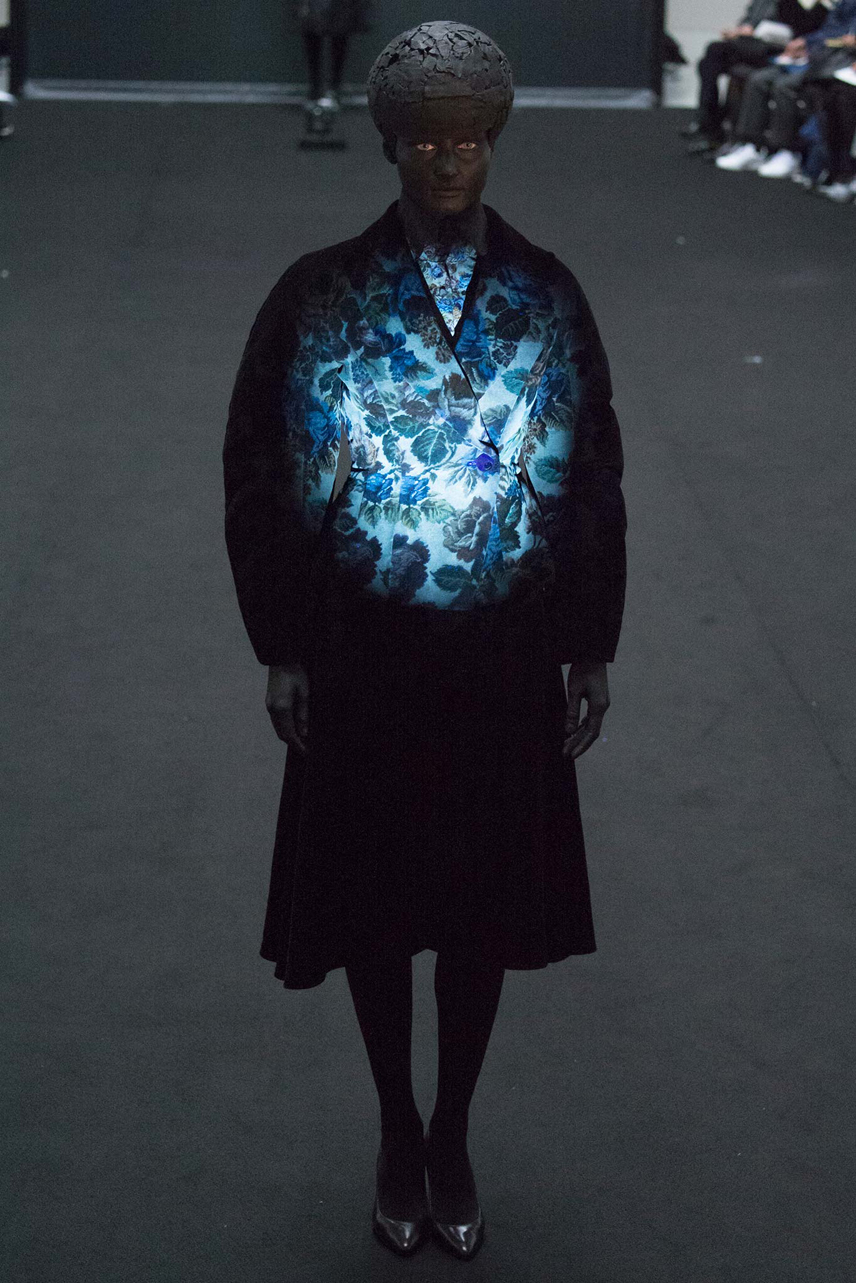
KUNIHIKO MORINAGA
森永邦彦
쿠니히코 모리나가
くにひこ もりなが
КУНИХИКО МОРИНАГА
Anrealage
Kunihiko Morinaga, the creative director of cult Japanese label Anrealage, has a thing for sensations and optical illusions. His debut Paris show last season was about light and shadow. Today, his sophomore outing focused on light and dark. Or, better, on the impressions you get from flashing or projecting light in pitch black. The Anrealage sculptural silhouettes were cut in a special black fabric that revealed a printed texture only under ultraviolet lights, or had needle-punched white circles—like a spotlight projection—splattered across the front. To emphasize the depth of such darkness, everything was black, including models’ faces, a heavy stroke that made things a little too dramatic.


FELICE VARINI
Felice Varini est un grand maître dans l’art complexe de l’illusion d’optique. Depuis 1979, ce peintre suisse utilise l’architecture comme toile de fond. À partir de relevés, il définit un point de vue à partir duquel la forme, toujours géométrique, pourra être vue dans son ensemble par le spectateur. Lorsque l’on se déplace, une infinité d’autres points de vue se créent pour offrir de multiples lectures de la forme déconstruite.

ADAM FERRISS
“Adam Ferriss is one of those technologically-minded creatives who is able to put his ever-growing knowledge of code and processing to use building aesthetically wondrous digital art for the rest of us to enjoy. His images make me feel like I’ve just taken some psychedelics and stepped into one of those crazy houses you get in funfairs, where there are giant optical illusions on every wall and the floor keeps moving under your feet, except these are made using algorithms and coding frameworks […]”

JIM CAMPBELL
led-explosion
“Jim Campbell (b1956) is a San Francisco-based artist who has embraced the connections of light, space and time, as few others have. He uses LED technology and his skills in electrical engineering to masterfully achieve what Andrei Tarkovsky called “sculpting in time”. He introduces the illusions and our minds complete them.” DARRAN ANDERSON
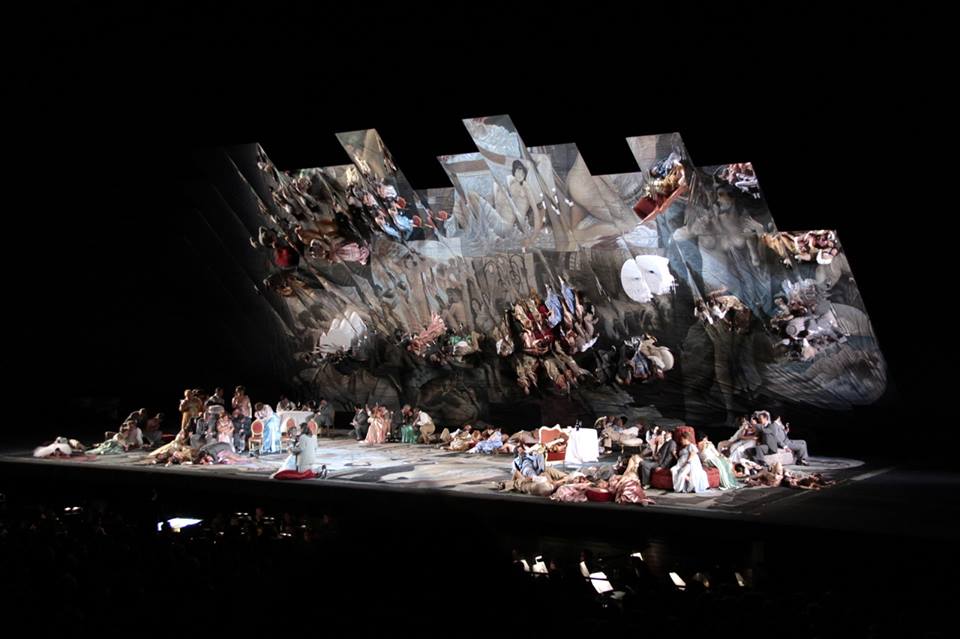
JOSEF SVOBODA
جوزيف سفوبودا
ЙОЗЕФА СВОБОДЫ
la traviata de verdi (Scenografia)
La technologie et la scénographie
Svoboda utilise les techniques de pointe en éclairage, en projection d’image et en mécanique de scène (scène cinétique) afin de s’affranchir des contraintes du lieu théâtral. La scène est pour Svoboda un instrument et un espace magique, lieu d’action de forces dramatiques, réelles, et non pas un espace illusionniste. La scénographie est une des disciplines de l’art théâtral, une composante de la mise en scène et un élément essentiel de la représentation. Elle doit donc d’être dynamique et se transformer dans le temps pour épouser l’action dramatique. La scénographie a un langage propre en tant que discipline à part entière. Svoboda apporte une contribution importante à ce langage par son travail sur la lumière et l’espace.
Lumière, matière et espace
Svoboda dit percevoir la lumière physiquement, et non pas simplement visuellement ; il trouve en elle l’inspiration pour son travail. Tout en reconnaissant son statut ” immatériel “, il la considère comme l’élément fondamental de la scénographie et la traite comme un matériau. D’abord formé en menuiserie, Svoboda affectionne particulièrement les matières brutes, notamment le bois. L’architecture représente pour lui, et ce dès son jeune âge, la somme des connaissances humaines. Formé en architecture d’intérieur, il s’intéresse à l’organisation de l’espace, à la rencontre scénique de l’architecture et du décor. Il privilégie les formes simples : la sphère, le cube et l’escalier. Svoboda croit que ” la mise en scène à l’italienne, bien qu’elle ne corresponde plus aux exigences des méthodes scénographiques actuelles, reste toujours la meilleure “.
Adrien M / Claire B et Mourad Merzouk
Pixel
A Small tease of the hour long presentation Intertwining body movement with technology is no easy feat. The Dance show is 11 dancers in a virtual and living visual environment. It took the collaborative artistic efforts of artists Adrien Mondot, Claire Bardainne from Adrien M/Claire B Company and Mourad Merzouk from his dance company Käfig to bring to life Pixels. A work on illusion combining energy and poetry, fiction and technical achievement, hip hop and circus.
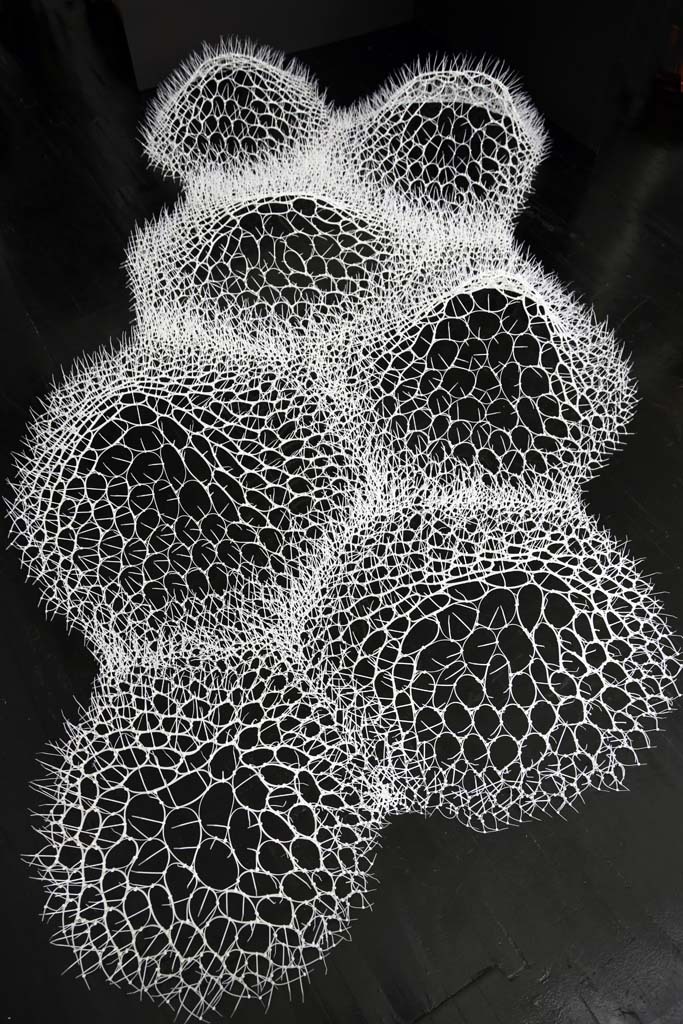
Sui Park
Her Contour
My work involves creating a 3-dimensional flexible organic form of a comfortable ambiance that is yet dynamic and possibly mystical or illusionary. It is an abstract representation of objects or concepts that recreates our surroundings. It can be interpreted in various ways including landscapes, living organisms, social ideas or values, anything that we accept as given that they exist. Through my work, I try to create an opportunity for audiences to see, think and most of all feel our surroundings from various perspectives.

HOWARD SCHATZ
Говард Шатц
הווארד שץ
霍华德沙茨
هوارد كاتس
H2O
Howard Schatz takes full advantage of the all the properties of water and pull off the most amazing shots. He loves capturing the optical illusions created by the refraction of light off the water’s surface. Being underwater also lends his models a certain grace that is heightened by the gauze-like material they wear. Howard Schatz is a prolific photographer who has received international acclaim for his work. He rose to stardom in the 1990s with his two collections of underwater photography […]
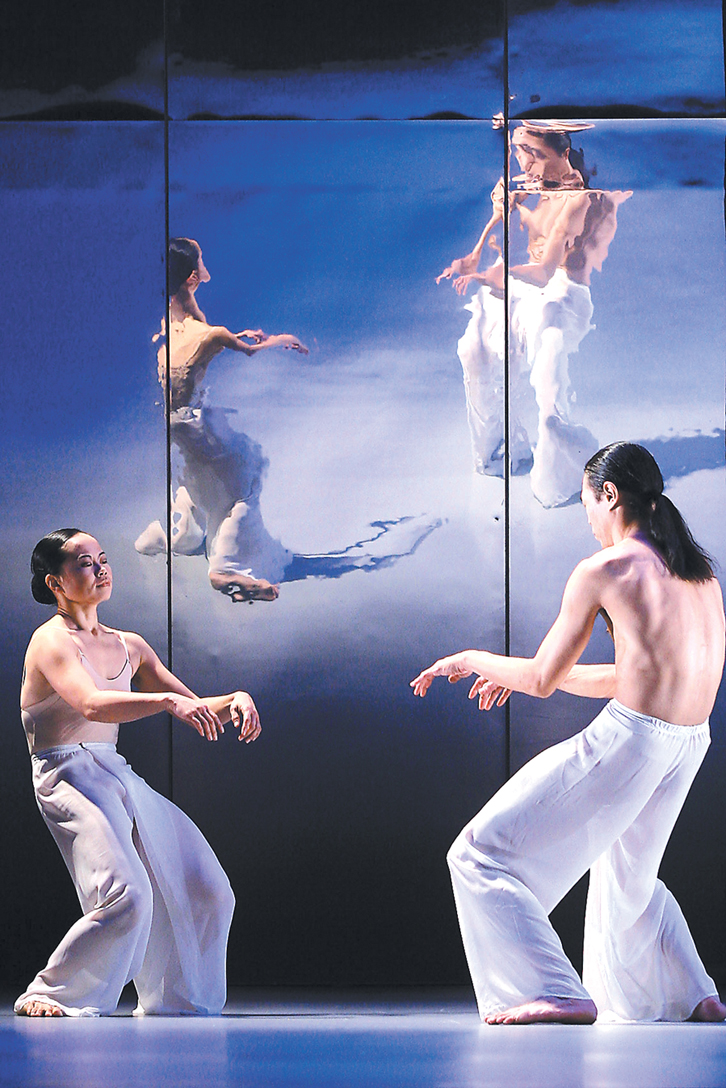
Lin Hwai-min
White Water and Dust
Set to the piano scores by Erik Satie and other composers, White Water is a lyrical dance of pure movement that flows beautifully as its title suggests. The curtain opens to a projected colour image of a flowing river; it slowly transforms into black and white. In serenity and in turbulence, whiteness of waves and ripples streams out of the blackness. Green netting and girds used for digital design interrupt the flow of water, thus revealing the process of creating virtual images and illusion of light, providing a pleasant surprise to the dance.
Cloud Gate
Cloud Gate is the name of the oldest known dance in China. In 1973, choreographer Lin Hwai-min adopted this classical name for the first contemporary dance company in the greater Chinese-speaking community.

james turrell
جيمس توريل
詹姆斯·特瑞尔
ג’יימס טורל
ジェームズ·タレル
설치작품 제임스 터렐
ДЖЕЙМСА ТАРРЕЛЛА
Skyspace
Manipulating light as a sculptor would mold clay, James Turrell creates works that amplify perception. Unlike pictorial art that replicates visual experience through mimetic illusion, Turrell’s light works—one cannot call these shimmering events ”objects“ or ”images“—give form to perception more…
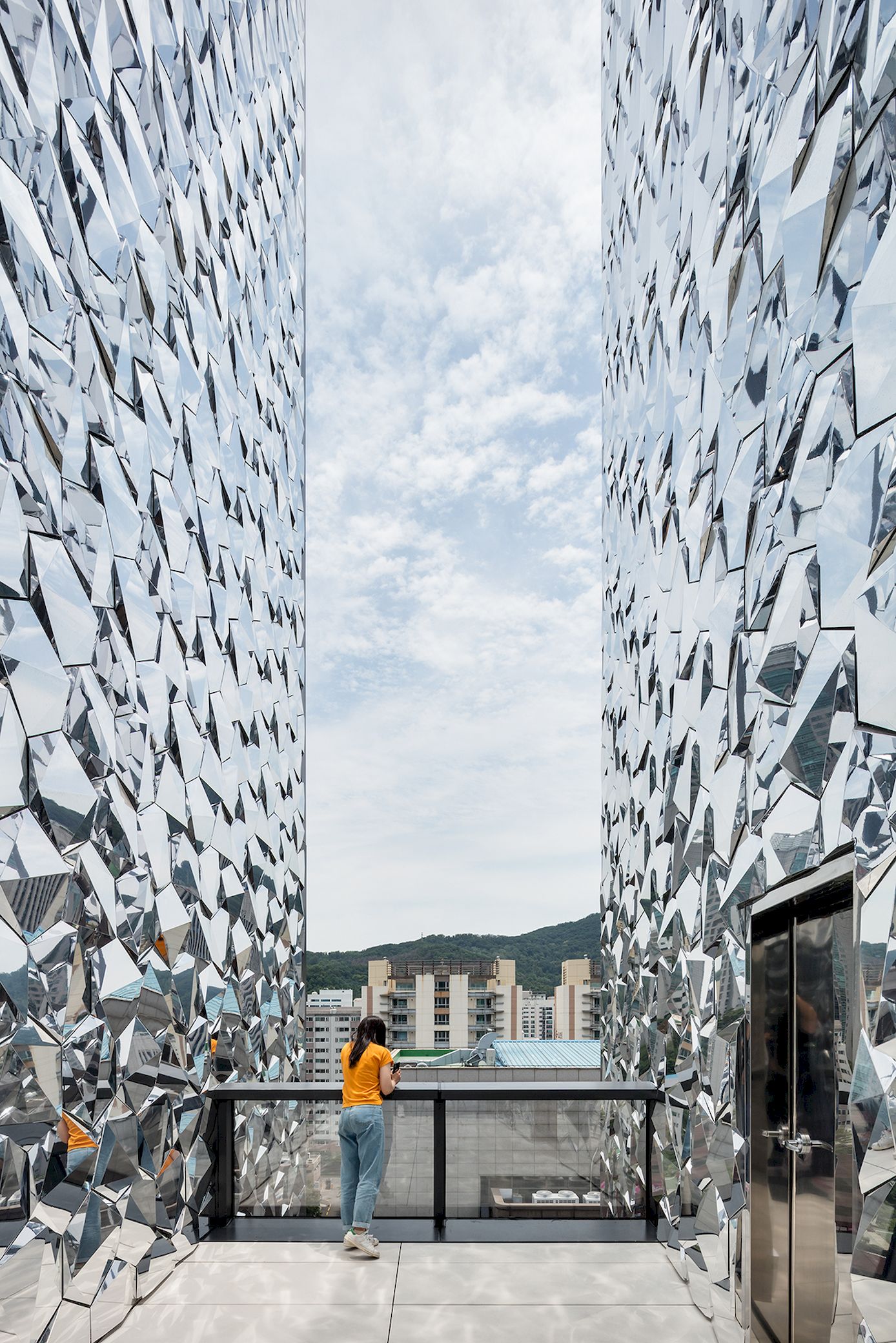

LORI HERSBERGER
Geist No.15
“L’art de Lori Hersberger met l’accent sur l’opposition entre le monde de l’illusion et celui de la réalité, tout en faisant allusion à l’espace qui les sépare. En ce sens, ses œuvres sont à la fois sublimes et grotesques – une combinaison qui est également clairement exprimée dans ses expositions actuelles “Lori Hersberger
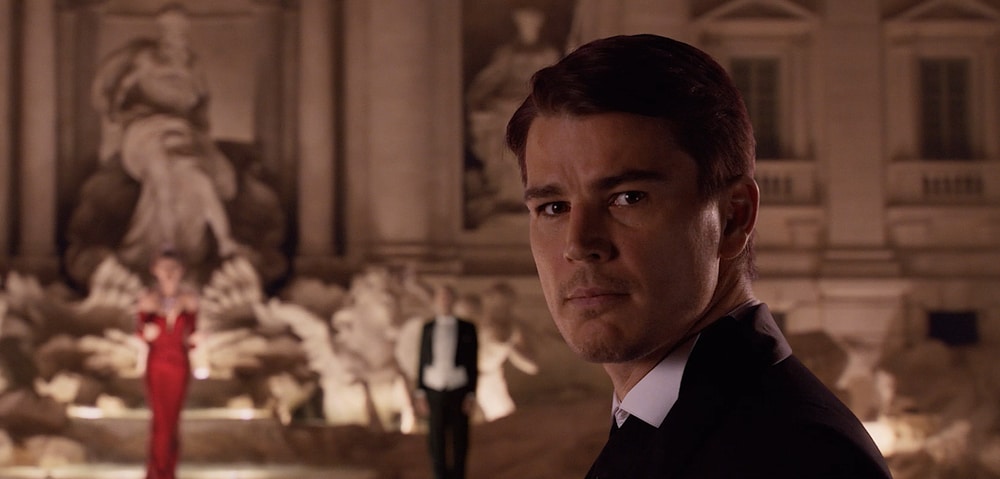
Lech Majewski
the Valley of the Gods
Valley of the Gods weaves together three narrative threads, mixing with the world of myths inspired by the Indian tribe legends about the ancient hero Ullikummin. “I am fascinated by the beauty and poetry of this mythology. It illustrates the contrast of primitive America with the current, equally surreal culture of America’s myth. With the culture of mass media and dreamed-up film illusions. It is summarised, among others, by the phrase ’sky is the limit’, demonstrating that everyone can become enormously rich”, director Lech Majewski said in a statement.

SARA SCHNADT
NETWORK
Sara Schnadt explores technology in her work both as subject and media. Her installations and performances use found objects, interactivity, projection, spatial illusions, and movement derived from common gestures. Much of her work involves representations or data that translate large quantities of socially resonant information into poetic forms, including data visualization. Schnadt often performs within accompanying sculptural environments, or sites works within functioning everyday spaces, attempting to articulate the personal within virtual and technological innovation.

Jennifer Steinkamp
Jennifer Steinkamp uses computer animation to create video projections and immersive installations, dynamic works that explore the relationship between architectural space, motion, and perception. When projected, Steinkamp’s dimensionally modeled images create the illusion of receding space, generating a dialogue with the real space occupied by the viewer. Steinkamp’s imagery ranges from abstract undulating forms to subjects drawn from nature, such as the cascade of flowers in her 2008 series, “It’s a nice day for a white wedding.”
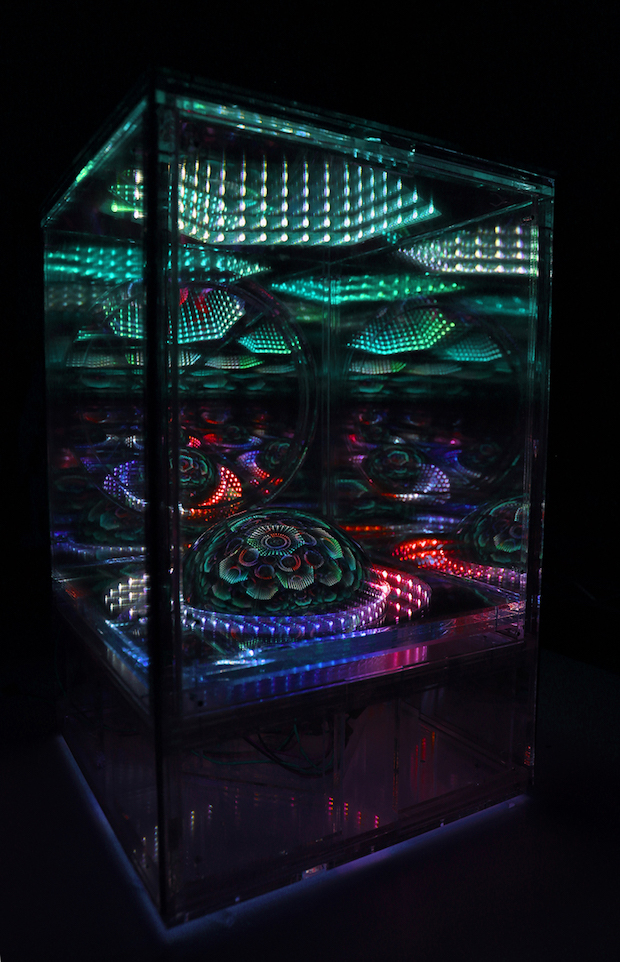
gabriel pulecio
Saturn Submerged
Saturn Submerged is part of an ongoing series of infinite boxes that creates an expanded infinite space within itself. The sculpture is composed of multiple mirrored surfaces and LEDs, which are fused to create the illusion of infinite depth and imagery. Mirrors include convex domes and walls; LEDs are programmed to continuously change in randomized combinations of almost infinite colors and sequences based on several variables.

TERRY HAGGERTY
British-born artist Terry Haggerty, who currently lives and works in Berlin, is known for his paintings that express the formalist vocabulary of abstraction in a new way. Light-colored stripes alternate with darker ones to form regular, often horizontal arrangements, which also have a pattern like quality due to their dense structure. The special thing about them is, that Haggerty breaks this linear formation at the edges of the painting by bending the lines in a different direction as the boundaries of the painting would support. His method transforms the structure of the painting into a illusory perception of three-dimensionality within the image. The surface seems to continue beyond+the+boundaries of the picture and reflects the illusion of a third dimension back onto the pictorial motif.
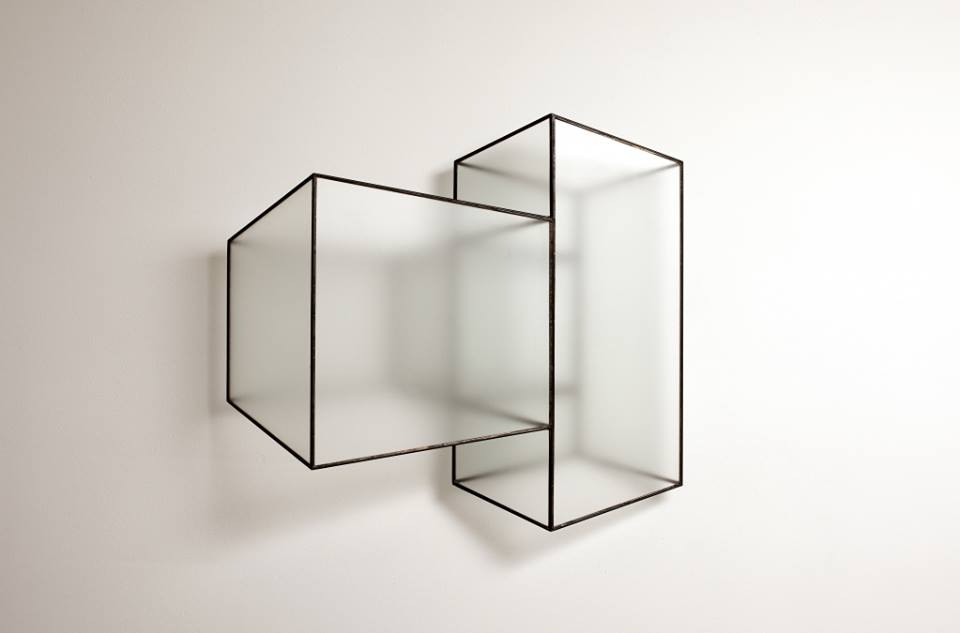
REINOUD OUDSHOORN
Reinoud Oudshoorn gebruikt perspectief, afkomstig uit de illusionaire taal van de schilderkunst en gebruikt die in zijn beelden. Op die manier wil hij een brug slaan tussen de ruimtelijke illusie van het platte vlak en de concrete realiteit van het driedimensionale beeld Oudshoorn’s beelden ontstaan vanuit het staren en kijken naar een wit vlak, dat geleidelijk in een ruimte verandert. Daaruit komen tekeningen voort. De keuze voor een materiaal hangt samen met de gekozen tekening en met de technische mogelijkheden: ijzer verwijst naar grafiet, hout is interessant vanwege de lijnen van de nerf, matglas geeft diepte. Een schilderij is hem teveel een illusie en een driedimensionaal beeld teveel realiteit.

